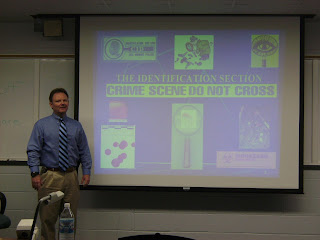
By Dawn Campbell
“Solving a crime does not happen in an hour and we don’t wear thousand dollar suits,” Sergeant Mike McDermott of the Des Moines Police Department (DMPD) told participants of the first Asian Citizens Academy. The statement dissolved any assumptions that crime scene investigations occur exactly as they do on the numerous CSI programs.
McDermott, who has been with the department 20 years this August, spoke to the academy class this past week regarding how DMPD’s crime scene investigation section operates. McDermott shared his experience which includes, approximately 10 years of working with crime scene investigation.
The identification unit is the only part of the detective’s bureau which operates 24-7, 365 days a year. It consists of a lieutenant, two sergeants, 13 identification technicians and one secretary.
This department is the best identification and investigation unit in the state. “We have a nationally recognized blood splatter expert as part of the team,” McDermott told attendees. The unit also has someone who is considered very knowledgeable and is highly regarded in the area of fingerprints.
McDermott proceeded to share some of the major accomplishments this particular division has achieved. One of those accomplishments occurred approximately 10 years ago. DMPD’s identification unit was the first crime scene investigation unit to ever raise a fingerprint off of a dead body.
After McDermott told about the structure and accomplishments of this staff, he shared a slide show with the class. “If anyone has a weak stomach, this may be a good a time to leave the room,” he warned.
McDermott began a homicide crime scene slide show. He stated with homicide investigations, crime scene investigators can be at the scene of the crime two to three days.
The class sat very still and quietly viewed the slide show which included the photos of an actual crime scene, evidence and autopsy photos used to prosecute a suspect in an especially violent homicide case which occurred about eleven years ago. McDermott shared what detectives learned during the investigation with the class. “The victim was random,” he said referring to the fact the suspect in the case did not know the victim. The victim’s body was discovered by their relative; McDermott believed the body was found by the victim’s daughter.

As the slide show progressed to the autopsy photos, the horrific act of violence was exposed and one attendee exited the room. “This person I believe has a special place in heaven because they fought back,” stated McDermott. The autopsy photos clearly showed numerous defensive stab wounds on the victim’s hands and arms. McDermott asked the class to count the wounds, but everyone remained silent. McDermott said quietly, “Too many to count.”
At the end of the slide show, a class participant asked how he does his job. McDermott answered, “What bothers me is that some times my job doesn’t bother me.”
McDermott then shared an experience and a piece of advice he was given early on in his career. The Drake Diner murders were the first crime scene McDermott ever worked. McDermott asked the class how many had been inside the diner. Most of the class raised their hands. He shared the layout of the diner to those who were not familiar. Then, McDermott shared how he walked in the diner, saw the victim’s bodies lying close to the entrance and how he looked at the walls which were very far away and were covered with blood and brain matter.
The piece of advice given to McDermott by a supervisor that night was, don’t look at bodies as people; look at the bodies as evidence.



No comments:
Post a Comment